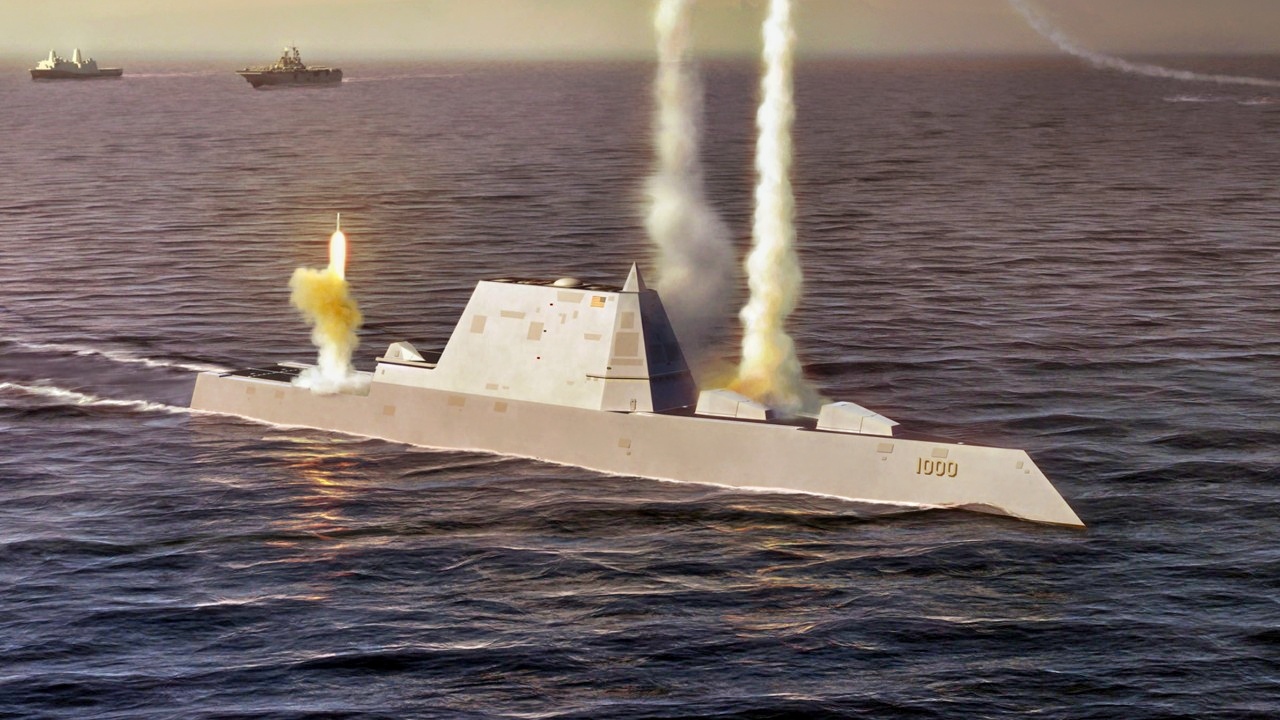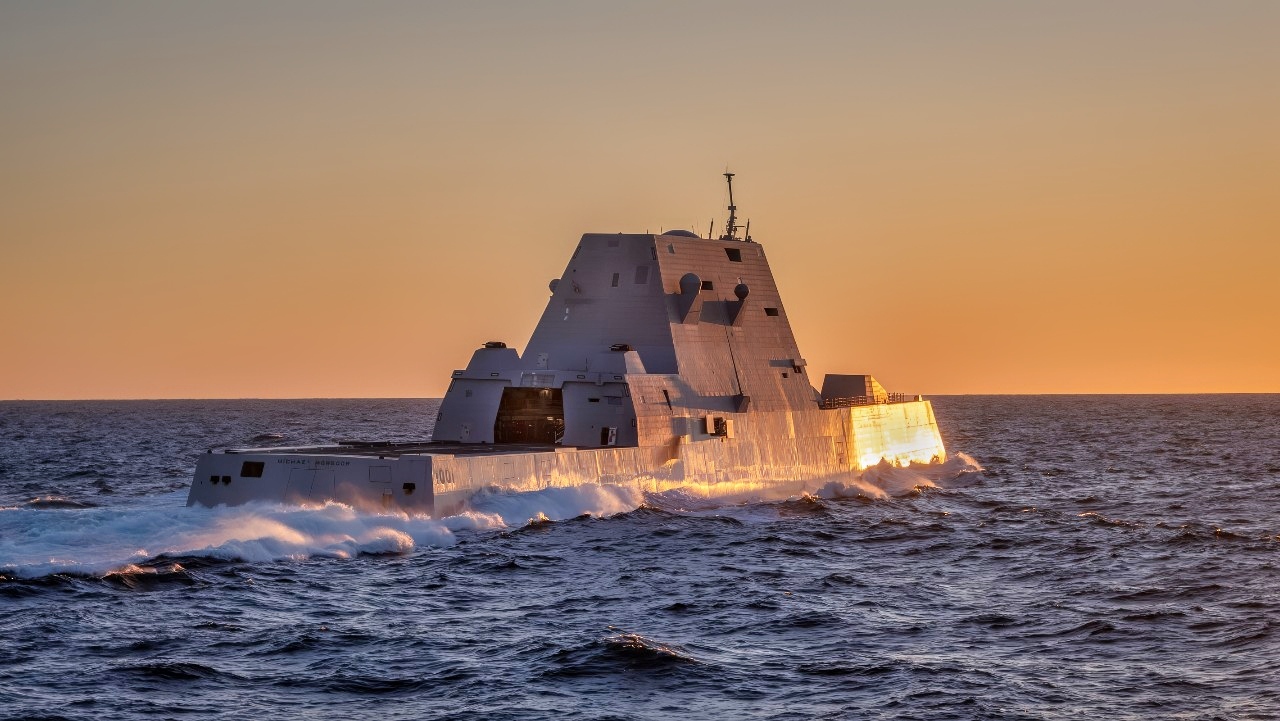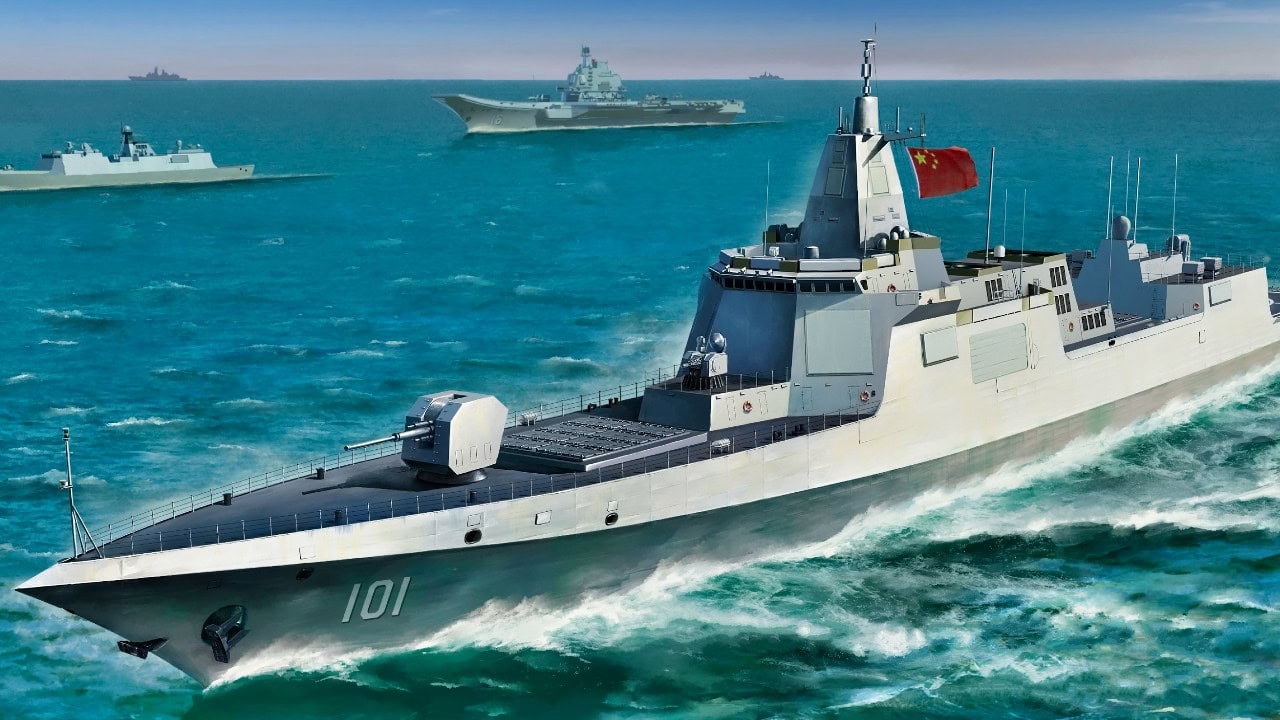Key Points and Summary – China’s naval modernization is rapidly advancing beyond just ship numbers, focusing on new stealth platforms for its A2/AD strategy.
-These include the new 6,000-ton Type 054B frigate, the formidable 13,000-ton Type 055 “cruiser” with 112 VLS cells, and advanced unmanned systems like the mine-laying AJX002 UUV.

The US Navy’s troubled Zumwalt-class destroyers are being revitalized with the integration of Conventional Prompt Strike (CPS) hypersonic missiles, transforming them into powerful long-range strike platforms. The original class of 32 ships was cut to just three after its Advanced Gun System failed due to exorbitant costs. Now, these stealthy, $8 billion warships are having their defunct guns replaced with vertical launch tubes for hypersonic weapons. This upgrade will dramatically increase their strike range from a mere 63 miles to over 1,700 miles, making the Zumwalts relevant and formidable assets for deterring adversaries like China in the 21st century.
-While the U.S. Navy retains superior experience and undersea tech, China’s ability to mass-produce and “afford to lose more ships” creates a “dangerous” “attrition” problem that U.S. shipyards cannot match.
China’s Navy Is Looking Like a Real Powerhouse
A lot of attention has been given to China’s rapidly advancing naval might, especially regarding new aircraft carriers and stealth fighters, such as the J-35, on those carriers.
However, not as much attention has been paid to the strides the Chinese Navy, or PLAN, has made in many areas.
China’s industrial prowess allows it to outproduce the U.S. in terms of raw tonnage, but now its navy is becoming more and more advanced.
Recently, China has been investing in more advanced naval stealth systems as a direct challenge to the U.S. Navy.
These newer systems range from surface vessels such as corvettes and destroyers to smaller systems such as drones and UUVs.
All of them are built to operate within China’s Anti-Access/Area Denial (A2/AD) doctrine, which seeks to keep U.S. forces at bay in the Western Pacific, particularly around Taiwan and the South China Sea.
The Type 054 Frigate
Among the newest additions to China’s fleet is the Type 054B frigate, commissioned in early 2025. This vessel represents a significant leap over its predecessor, the Type 054A.
It displaces roughly 5,500 to 6,000 tons, compared to the 4,000 tons of the earlier model, and measures about 150 meters in length with a beam of 17 to 18 meters.
Powered by CODAD diesel engines, it can reach speeds of 28 knots and has a range of approximately 5,000 nautical miles.
The frigate incorporates radar-absorbent materials and an angular superstructure to reduce its radar cross-section, along with an enclosed bow anchor.
Its sensors include a dual-face rotating AESA radar, which improves tracking and targeting capabilities.
The Type 054Bs armament consists of a 32-cell Vertical Launch System for HQ-16 surface-to-air missiles and Yu-8 anti-submarine weapons, eight YJ-83 anti-ship missiles, a 100 mm main gun, and close-in weapon systems.
It also carries a Z-20 helicopter for anti-submarine warfare and surveillance.
The Type 054B is designed as a multi-mission platform for air defense, anti-submarine warfare, and surface strike.
While not a game-changer on its own, mass production of this class could overwhelm U.S. forces in a distributed fight, particularly in congested littoral zones like the South China Sea.
The Type 055 Destroyers
Even more formidable is the Type 055 destroyer, often classified as a cruiser by NATO due to its size and capabilities. Displacing between 12,000 and 13,000 tons, it rivals the U.S. Ticonderoga-class cruisers.
The Ticonderoga Class Cruiser USS Normandy (CG 60) steams at sunset in the Atlantic Ocean while operating with the USS George Washington battle group on May 18, 2000. The Normandy, homeported in Norfolk, Va., is participating in a Joint Task Force Exercise with the battle group.
(DoD photo by Petty Officer 2nd Class Shane McCoy, U.S. Navy. (Released))
The Type 055 carries 112 Vertical Launch System cells capable of deploying a mix of HHQ-9 surface-to-air missiles, YJ-18 anti-ship missiles, CJ-10 land-attack cruise missiles, and anti-submarine weapons. It is equipped with a 130 mm naval gun, close-in weapon systems, and torpedo tubes.
Its sensors include the Type 346B AESA radar and an integrated combat system similar to the U.S. Aegis system. Stealth features include an angled hull, enclosed structures, and an integrated mast with a flush deck design to minimize radar signature.
The Type 055 is intended for blue-water operations, carrier escort, and area air defense. With eight ships already in service and more under construction, this class provides China with a true blue-water capability, enabling power projection far beyond the first island chain and challenging U.S. dominance in the Indo-Pacific.
China’s Naval Drones
China has also poured immense resources into naval drones. According to some reports, the PLAN is experimenting with unmanned missile carriers, including trimaran-hulled arsenal ships that function as floating missile magazines.
These platforms, designed with stealthy profiles, could carry large numbers of cruise missiles and operate semi-autonomously, relying on external targeting networks.
Their low radar signatures make them challenging to detect and enable them to saturate U.S. defenses, especially when deployed in swarms.

(February 10, 2024) — The Zumwalt Class Guided Missile Destroyer USS Michael Monsoor (DDG 1001) breaks away from the Henry J. Kaiser-class fleet replenishment oiler USNS Pecos (T-AO 197) shortly before sunset after taking on fuel. (U.S. Navy photo by Chief Mass Communication Specialist Mark D. Faram)
This concept aligns with China’s doctrine of distributed lethality, which seeks to complicate U.S. targeting and exploit gaps in anti-drone naval defenses.
Aside from this potential new missile carrier, China has been investing in naval drones of all types, from submersible UUVs to smaller surface-kamikaze vessels.
During China’s 2025 Victory Day parade, the PLA showed off a number of new systems that are expected to be added to the PLAN in the near future.
This includes the HSU100 uncrewed underwater vehicle, which is intended for underwater surveillance and intelligence gathering.
The AJX002 UUV is an autonomous submersible drone reportedly specialized in remote mine-laying and anti-submarine warfare.
These are just two of many autonomous systems China is currently employing, all of which incorporate some form of low-observable feature.
Why the U.S. Navy Should be Taking Notes
These systems should be a significant concern for the U.S. Navy for several reasons.
China’s ability to mass-produce ships gives it a numerical edge, and its A2/AD systems, combined with stealth ships, long-range missiles, and submarines, can create no-go zones for U.S. carriers.
Furthermore, China concentrates its forces in the Western Pacific, whereas the U.S. Navy must operate globally. However, China still faces significant challenges.
The U.S. Navy has unmatched operational experience in sustained blue-water combat, and American carrier air power remains decisive for power projection.
The U.S. also retains technological superiority in undersea and electronic warfare, as well as integrated battle networks.
That being said, in a Taiwan contingency or South China Sea clash, China’s stealth frigates and destroyers would complicate U.S. operations, especially when combined with missile salvos and drones.
They do not yet guarantee Chinese dominance, but the real danger lies in attrition. China can afford to lose more ships and still maintain combat power, while U.S. replacements would take years to build.
This asymmetry could erode U.S. deterrence over time.
About the Author: Isaac Seitz
Isaac Seitz, a Defense Columnist, graduated from Patrick Henry College’s Strategic Intelligence and National Security program. He has also studied Russian at Middlebury Language Schools and has worked as an intelligence Analyst in the private sector.
More Military
The M113: America’s “Forgotten” APC That Just Won’t Quit
How British Aircraft Carriers Keep Sinking in War Games
Boeing F-47 NGAD Fighter: One Missing Fact Could Decide Its Fate
Canada Knows How to Sink U.S. Navy Nuclear Aircraft Carriers











Jim
November 7, 2025 at 12:11 pm
This run down of China’s naval numbers and ability should be an eye opener.
Yes, the United States Navy has superior experience at blue water operations far from U. S. coastal waters. But China’s first priority is its coastal waters and environs.
This reduces the complexity of ongoing logistics & operations. And it also simplifies tactics & strategy for Chinese military planners & strategists.
All this goes into China’s Anti-Access/Area Denial (A2/AD) doctrine.
The author is right to point out the industrial capacity to put out superior numbers of naval ships with technological ability to possibly rival the U. S. Navy’s tech. (Does China have tactics & strategy to match their technological prowess?)
The military balance of forces between China and the United States in the Western Pacific outlined herein, puts muscle on the bone for why the Rand Corporation, a think-tank with long running links to the Pentagon, has called for a major policy shift regarding China: manage an ongoing relationship for the long-term without the assumption of an eventual military conflict against China.
For the Rand Corporation this is a significant shift as it has a track record of recommending aggressive long-term policy options geared to hegemonic dominance.
This recent report maybe a first for the Rand Corporation: recommending a strategic policy of getting along with China over the long-term.
What the author outlines, herein, maybe one of the reasons for the surprising conclusions in the Rand report.